How Boston Dynamics Is Redefining Robot Agility
 Gif: Bob O'Connor/IEEE Spectrum
Gif: Bob O'Connor/IEEE Spectrum With their jaw-dropping agility and animal-like reflexes, Boston Dynamics' bioinspired robots have always seemed to have no equal. But that preeminence hasn't stopped the company from pushing its technology to new heights, sometimes literally. Its latest crop of legged machines can trudge up and down hills, clamber over obstacles, and even leap into the air like a gymnast. There's no denying their appeal: Every time Boston Dynamics uploads a new video to YouTube, it quickly racks up millions of views. These are probably the first robots you could call Internet stars.
Spot Photo: Bob O'Connor
Photo: Bob O'Connor - 84 cm
HEIGHT
- 25 kg
WEIGHT
- 5.76 km/h
SPEED
SENSING: Stereo cameras, inertial measurement unit, position/force sensors
ACTUATION: 12 DC motors
POWER: Battery (90 minutes per charge)
Boston Dynamics, once owned by Google's parent company, Alphabet, and now by the Japanese conglomerate SoftBank, has long been secretive about its designs. Few publications have been granted access to its Waltham, Mass., headquarters, near Boston. But one morning this past August, IEEE Spectrum got in. We were given permission to do a unique kind of photo shoot that day. We set out to capture the company's robots in action-running, climbing, jumping-by using high-speed cameras coupled with powerful strobes. The results you see on this page: freeze-frames of pure robotic agility.
We also used the photos to create interactive views, which you can explore online on our Robots Guide. These interactives let you spin the robots 360 degrees, or make them walk and jump on your screen.
Boston Dynamics has amassed a minizoo of robotic beasts over the years, with names like BigDog, SandFlea, and WildCat. When we visited, we focused on the two most advanced machines the company has ever built: Spot, a nimble quadruped, and Atlas, an adult-size humanoid.
Spot can navigate almost any kind of terrain while sensing its environment. Boston Dynamics recently made it available for lease, with plans to manufacture something like a thousand units per year. It envisions Spot, or even packs of them, inspecting industrial sites, carrying out hazmat missions, and delivering packages. And its YouTube fame has not gone unnoticed: Even entertainment is a possibility, with Cirque du Soleil auditioning Spot as a potential new troupe member.
"It's really a milestone for us going from robots that work in the lab to these that are hardened for work out in the field," Boston Dynamics CEO Marc Raibert says in an interview.
Atlas Photo: Bob O'Connor
Photo: Bob O'Connor - 150 cm
HEIGHT
- 80 kg
WEIGHT
- 5.4 km/h
SPEED
SENSING: Lidar and stereo vision
ACTUATION: 28 hydraulic actuators
POWER: Battery
Our other photographic subject, Atlas, is Boston Dynamics' biggest celebrity. This 150-centimeter-tall (4-foot-11-inch-tall) humanoid is capable of impressive athletic feats. Its actuators are driven by a compact yet powerful hydraulic system that the company engineered from scratch. The unique system gives the 80-kilogram (176-pound) robot the explosive strength needed to perform acrobatic leaps and flips that don't seem possible for such a large humanoid to do. Atlas has inspired a string of parody videos on YouTube and more than a few jokes about a robot takeover.
While Boston Dynamics excels at making robots, it has yet to prove that it can sell them. Ever since its founding in 1992 as a spin-off from MIT, the company has been an R&D-centric operation, with most of its early funding coming from U.S. military programs. The emphasis on commercialization seems to have intensified after the acquisition by SoftBank, in 2017. SoftBank's founder and CEO, Masayoshi Son, is known to love robots-and profits.
The launch of Spot is a significant step for Boston Dynamics as it seeks to "productize" its creations. Still, Raibert says his long-term goals have remained the same: He wants to build machines that interact with the world dynamically, just as animals and humans do. Has anything changed at all? Yes, one thing, he adds with a grin. In his early career as a roboticist, he used to write papers and count his citations. Now he counts YouTube views.
- In the Spotlight
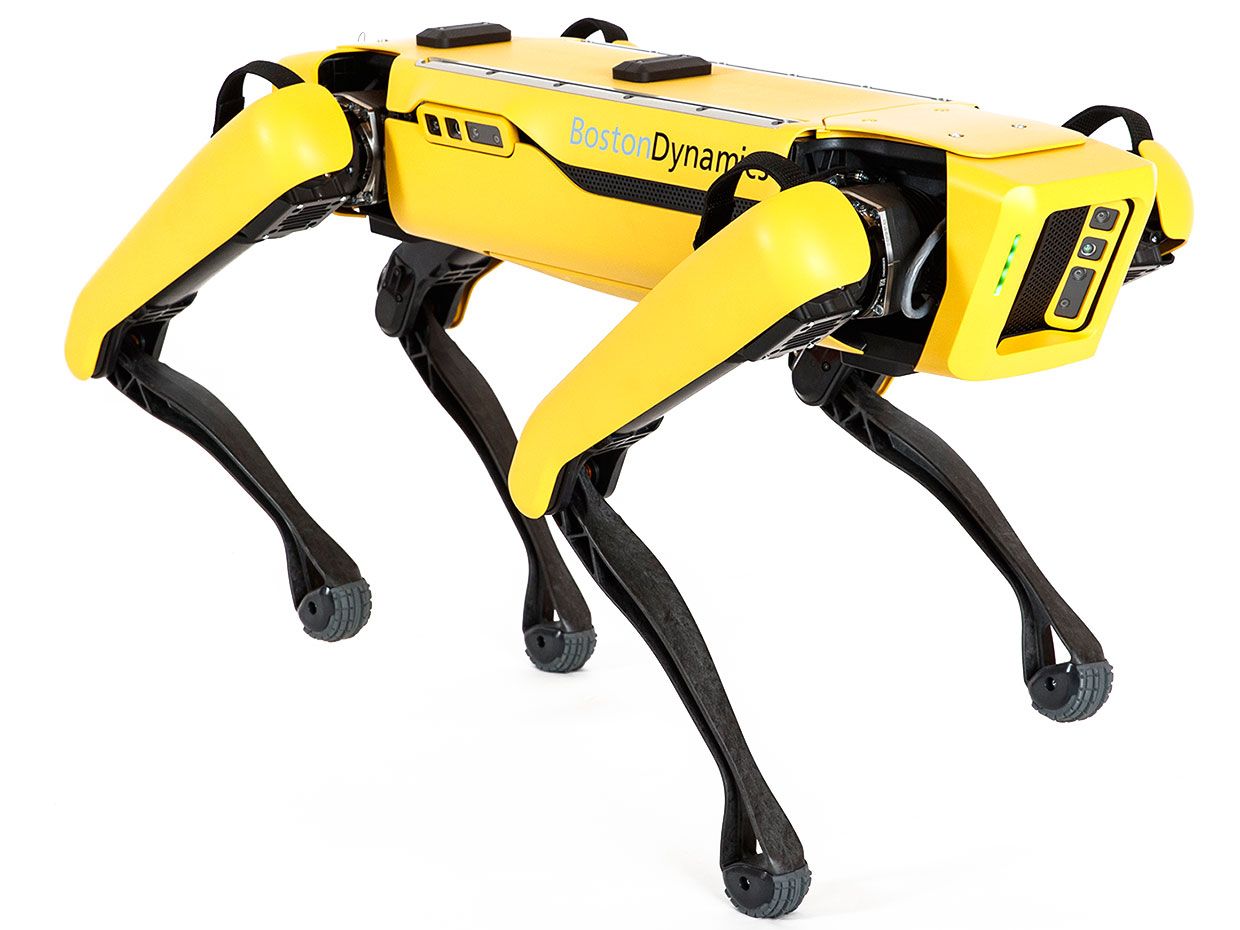 Photo: Bob O'Connor
Photo: Bob O'Connor Boston Dynamics designed Spot as a versatile mobile machine suitable for a variety of applications. The company has not announced how much Spot will cost, saying only that it is being made available to select customers, which will be able to lease the robot. A payload bay lets you add up to 14 kilograms of extra hardware to the robot's back. One of the accessories that Boston Dynamics plans to offer is a 6-degrees-of-freedom arm, which will allow Spot to grasp objects and open doors.
- Super Senses
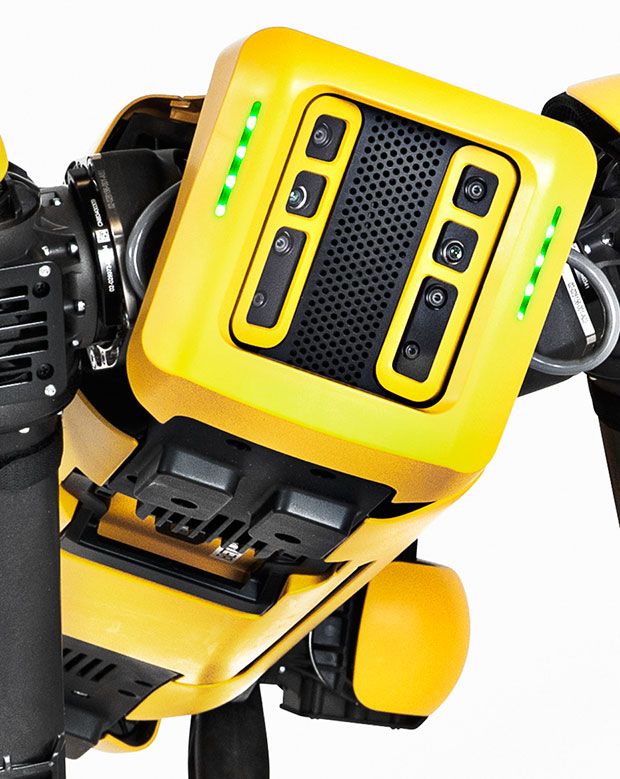 Photo: Bob O'Connor
Photo: Bob O'Connor Spot's hardware is almost entirely custom-designed. It includes powerful processing boards for control as well as sensor modules for perception. The sensors are located on the front, rear, and sides of the robot's body. Each module consists of a pair of stereo cameras, a wide-angle camera, and a texture projector, which enhances 3D sensing in low light. The sensors allow the robot to use the navigation method known as SLAM, or simultaneous localization and mapping, to get around autonomously.
- Stepping Up
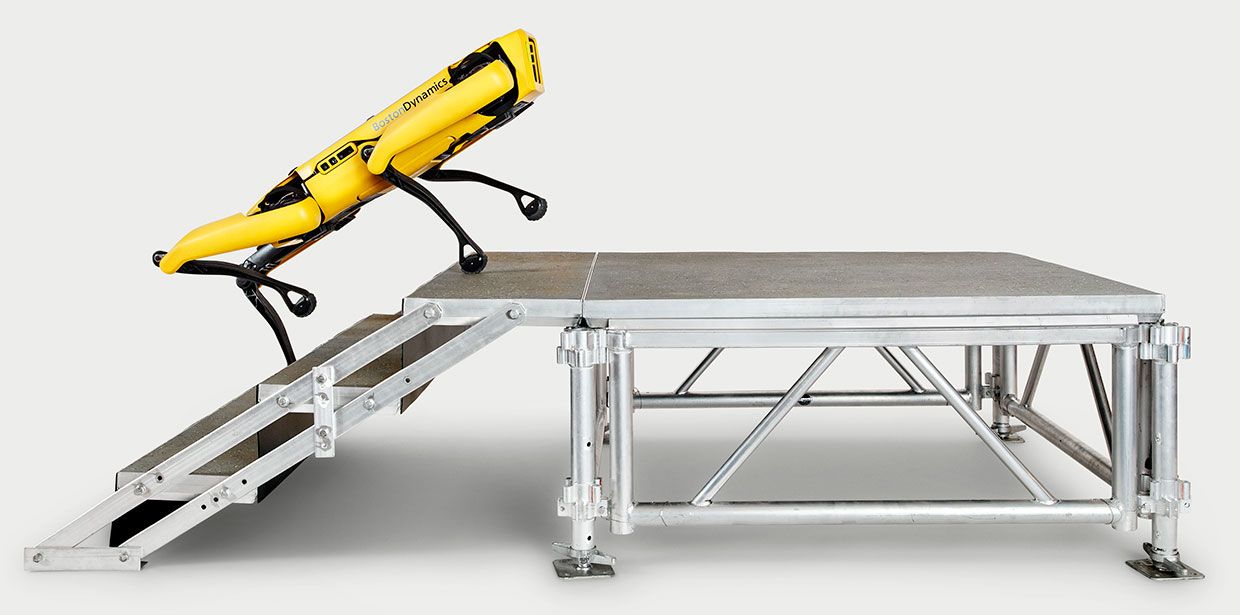 Photo: Bob O'Connor
Photo: Bob O'Connor In addition to its autonomous behaviors, Spot can also be steered by a remote operator with a game-style controller. But even when in manual mode, the robot still exhibits a high degree of autonomy. If there's an obstacle ahead, Spot will go around it. If there are stairs, Spot will climb them. The robot goes into these operating modes and then performs the related actions completely on its own, without any input from the operator. To go down a flight of stairs, Spot walks backward, an approach Boston Dynamics says provides greater stability.
- Funky Feet
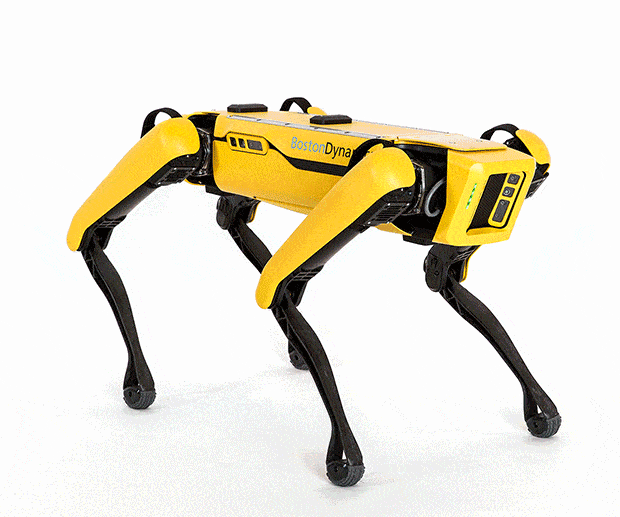 Gif: Bob O'Connor/IEEE Spectrum
Gif: Bob O'Connor/IEEE Spectrum Spot's legs are powered by 12 custom DC motors, each geared down to provide high torque. The robot can walk forward, sideways, and backward, and trot at a top speed of 1.6 meters per second. It can also turn in place. Other gaits include crawling and pacing. In one wildly popular YouTube video, Spot shows off its fancy footwork by dancing to the pop hit "Uptown Funk."
- Robot Blood
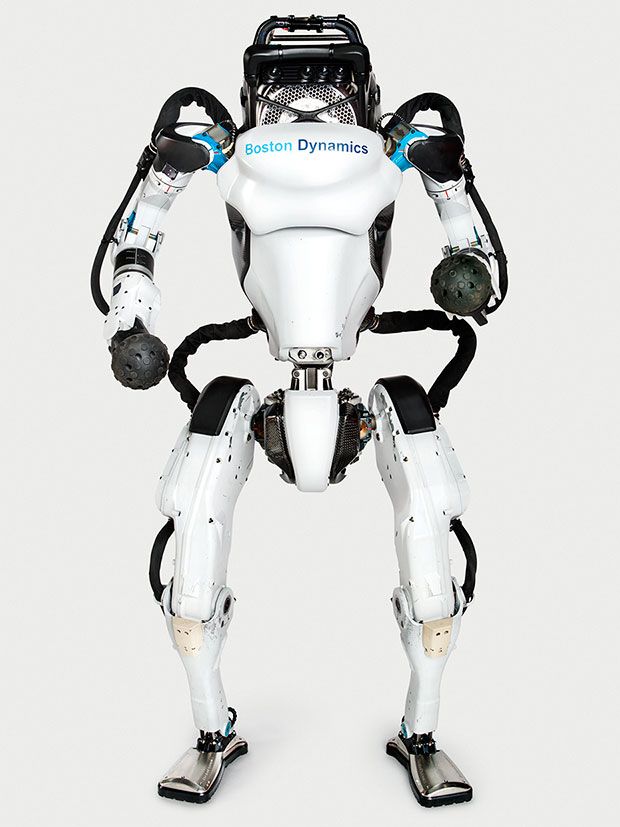 Photo: Bob O'Connor
Photo: Bob O'Connor Atlas is powered by a hydraulic system consisting of 28 actuators. These actuators are basically cylinders filled with pressurized fluid that can drive a piston with great force. Their high performance is due in part to custom servo valves that are significantly smaller and lighter than the aerospace models that Boston Dynamics had been using in earlier designs. Though not visible from the outside, the innards of an Atlas are filled with these hydraulic actuators as well as the lines of fluid that connect them. When one of those lines ruptures, Atlas bleeds the hydraulic fluid, which happens to be red.
- Next Generation
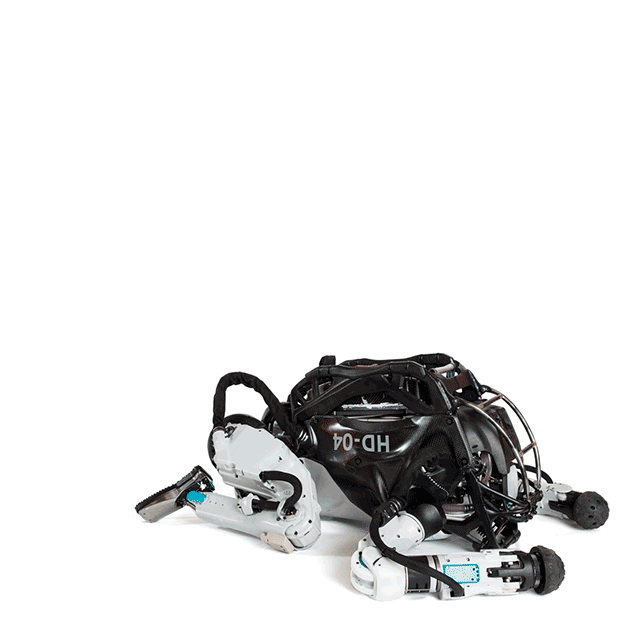 Gif: Bob O'Connor/IEEE Spectrum
Gif: Bob O'Connor/IEEE Spectrum The current version of Atlas is a thorough upgrade of the original model, which was built for the DARPA Robotics Challenge in 2015. The newest robot is lighter and more agile. Boston Dynamics used industrial-grade 3D printers to make key structural parts, giving the robot greater strength-to-weight ratio than earlier designs. The next-gen Atlas can also do something that its predecessor, famously, could not: It can get up after a fall.
- Walk This Way
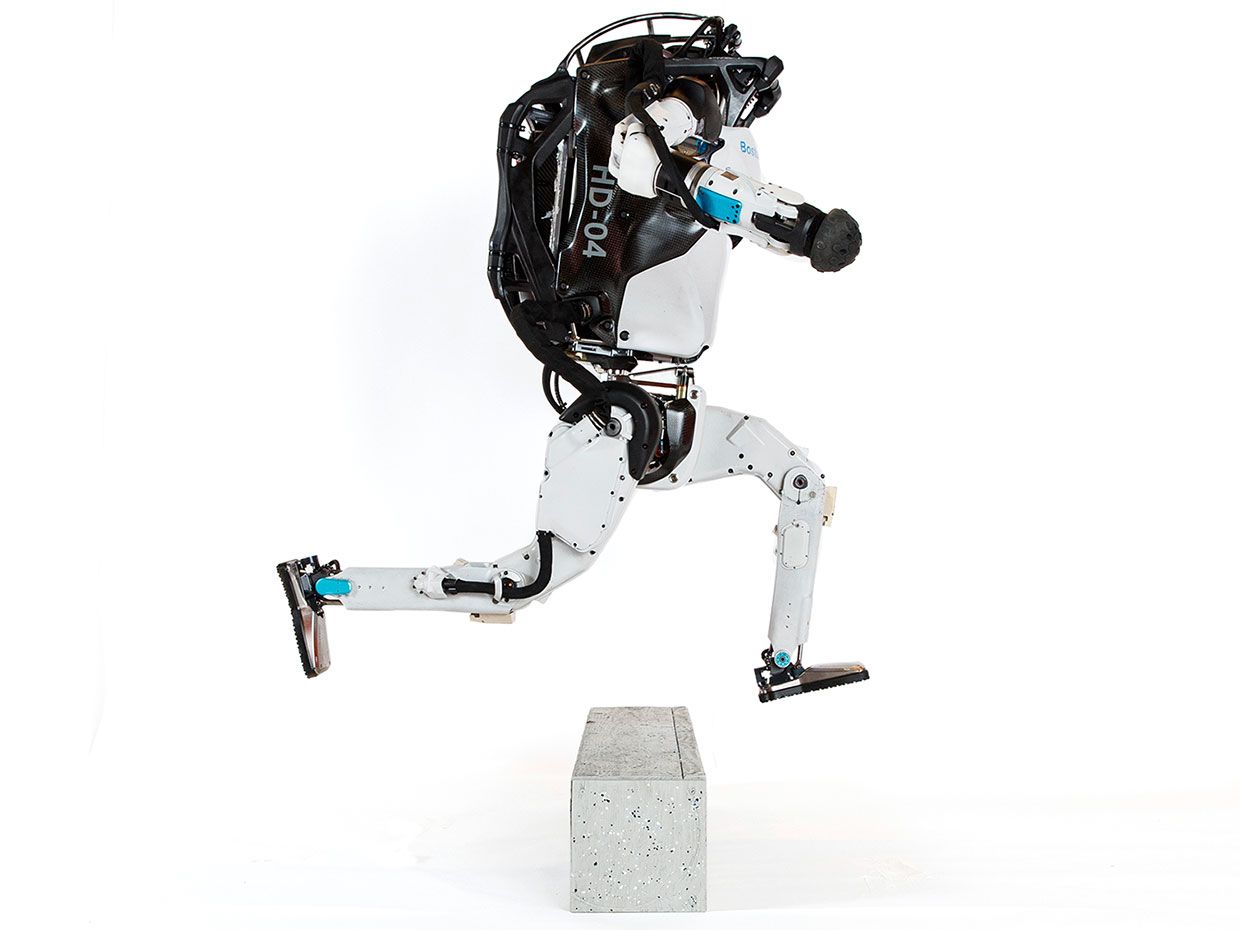 Photo: Bob O'Connor
Photo: Bob O'Connor To control Atlas, an operator provides general steering via a manual controller while the robot uses its stereo cameras and lidar to adjust to changes in the environment. Atlas can also perform certain tasks autonomously. For example, if you add special bar-code-type tags to cardboard boxes, Atlas can pick them up and stack them or place them on shelves.
- Biologically Inspired
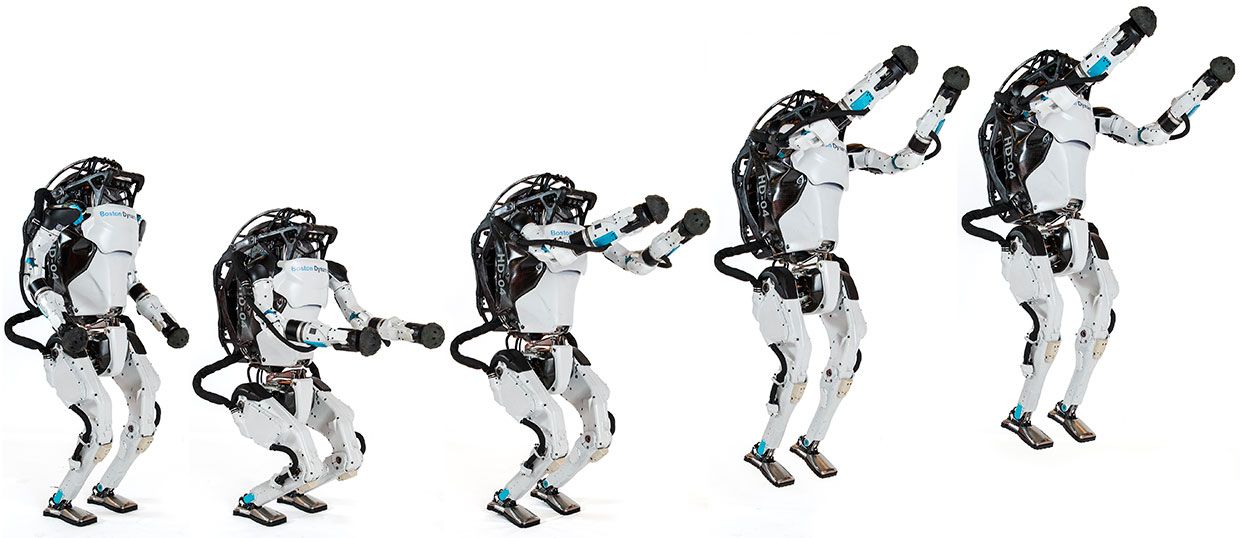 Photos: Bob O'Connor
Photos: Bob O'Connor Atlas's control software doesn't explicitly tell the robot how to move its joints, but rather it employs mathematical models of the underlying physics of the robot's body and how it interacts with the environment. Atlas relies on its whole body to balance and move. When jumping over an obstacle or doing acrobatic stunts, the robot uses not only its legs but also its upper body, swinging its arms to propel itself just as an athlete would.
This article appears in the December 2019 print issue as "By Leaps and Bounds."